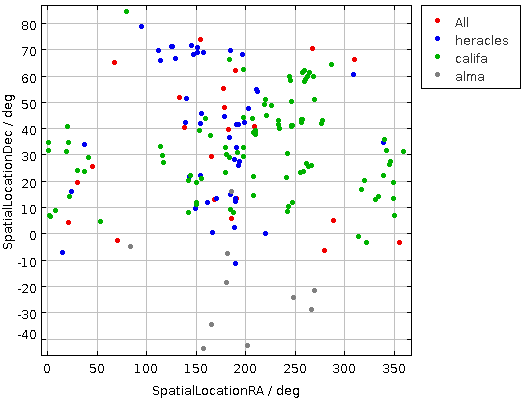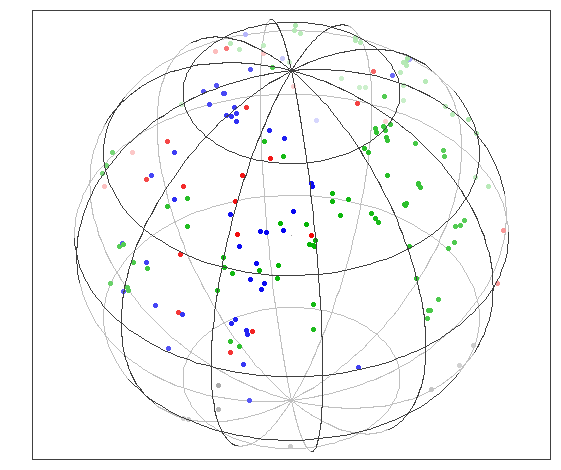VAO SIAv2 Prototype Effort
This page shares information on the VAO Project's effort to prototype an SIAv2 service. The goal is to demostrate key features and uncover practical lessons that can be folded back into the SIAv2 standardization process.Summer 2013 Prototype
In the spring 2013, the VAO, responding to feedback from the Spring 2013 Interop, developed a plan to build an SIAv2 prototype service by the Fall 2013 Interop. In particular, feedback from invited panelists representing leading archives resulted in a focus on basic dataset discovery and retrieval (over more advanced features, such as cutouts or reprojections). The VAO plan has four major phases:- Updating the relevant specifications, namely the Image Data Model WD and the SIAv2 protocol WD.
- Defining scope and schedule for the delivered prototype
- Implementation using the VAO DalServer code base as the platform
- Testing and evaluation of the deployed prototype
Regarding the Documents Used as Baseline Specifications
It was assumed from the start that the relevant IVOA Working Drafts, namely the SIAv2 prototol specficiation and the Image Data Model specification it is based on--would continue to evolve throughout the development period. For project management, this raise two concerns- the scope of the effort would be apt to "creep" to keep up with the evolving document
- it would be difficult to evaluate our prototype if the specification had evolved away from the version we started with.
Details
- Requirements, Scope, and Schedule
- VAO Baseline Specifications*:
- Results:
- VAO Presentation slides
- see pointers listed below
- Test Queries: enumerated below
Summary of Scope
This prototype is focused on data discovery and delivery via thequeryData operation. - No cutout or data extraction will be supported; only the download of full single datasets (via the Access.Reference attribute) will be enabled.
- Assume
MODE=archival
- Assume
- Synchronous queries are supported only (
/sync). - Assume
INTERSECT=OVERLAYS(any image overlaping query region is returned) - The focus of our testing will be on the required query parameters
-
POS,SIZE,BAND,TIME,POL,FORMAT - no support for the optional parameters was planned; support for some optional parameters was included but not formally tested.
-
- Output columns: required and recommended columns supported
- Note use of VOTable GROUPs to associate related columns
Datasets Used

 Our test collection is a diverse mix of 2-D and N-D images.
Our test collection is a diverse mix of 2-D and N-D images. - from ALMA, VLA, JVLA, Heracles, Califa, JCMT, JWST, CARMA
- includes traditional 2D images, 3D radio cubes, moment maps, sparse images
Results
Prototype service is deploy at http://vaosa-vm1.aoc.nrao.edu/ivoa-dal/siapv2/- IVOA colleagues are invited to submit queries to explore behavior
- start with test queries below, edit query in your browser to try variations.
- Browse on-line or download distribution tar-ball: dalserver-siav2proto.1.tar.gz
- "Friendly IVOAers" may build and deploy service on own (Linux) platform
- Requires Apache, Java, Tomcat, MySQL, Python
- Data files not included (thus, downloads wil not work)
- see prototype/README
- A web page form is also available
Test Queries
General Coverage Queries
| Title | return all images in a square region |
|---|---|
| Query | /sync?REQUEST=querydata&POS=202.48416,+47.23055&SIZE=0.033 |
| Should Return | VOTable listing 4 heracles images of NGC 5194 |
| Status | Passed. |
| Title | return all images in a rectangular region |
|---|---|
| Query | /siapv2/sync?REQUEST=querydata&POS=244,10&SIZE=6,4 |
| Should Return | VOTable listing 3 califa images |
| Status | Passed |
| Title | return all images in a region with supported frame |
|---|---|
| Query | /sync?REQUEST=querydata&POS=244,10;ICRS&SIZE=6,4 |
| Should Return | VOTable listing 3 califa images |
| Status | Passed |
| Title | restrict to spectral window |
|---|---|
| Query | /sync?REQUEST=querydata&BAND=0.21/0.22 |
| Should Return | VOTable listing 5 NED images and 5 VLA images |
| Status | Note: service complies with spec, but additional images returned due to null value handling |
| ID | 3.1.5 |
|---|---|
| Title | restrict to sky region and spectral window |
| Query | /sync?REQUEST=querydata&POS=21,+3.6;ICRS&SIZE=0.5&BAND=0.21/0.22 |
| Should Return | VOTable listing one NED image and 1 VLA image |
| Status | Open Issue (?) |
| Title | Time Coverage |
|---|---|
| Query | /sync?REQUEST=querydata&TIME=1992-01-01/1997-01-01 |
| Should Return | VOTable listing two NED image and 2 VLA image |
| Status | Note: service complies with spec, but additional images returned due to null value handling |
Polarization
| Title | Stokes V coverage |
|---|---|
| Query | /sync?REQUEST=querydata&POL=V |
| Should Return | VOTable listing only images with Stokes V coverage (This may be a null set) |
| Status | Passed |
| Title | Any polarization |
|---|---|
| Query | /sync?REQUEST=querydata&POL=any |
| Should Return | VOTable listing all images |
| Status | Passed |
| Title | Stokes I polarization |
|---|---|
| Query | /sync?REQUEST=querydata&POL=I |
| Should Return | VOTable listing all images that represent measurements of total intensity. (Should include any images that do not explicitly measure polarization?) |
| Status |
General Protocol Testing
| Title | Erroneous Query |
|---|---|
| Query | /sync?REQUEST=querydata&POS=asdfl&SIZE=0.1 |
| Should Return | VOTable with properly set INFO specifying error |
| Status | Passed |
| Title | return all images in a region with unsupported frame |
|---|---|
| Query | /sync?REQUEST=querydata&POS=245,10;GALACTIC&SIZE=2,4 |
| Should Return | VOTable with error contents indicating unsupported frame |
| Status | Query attempting an unsupported frame does not trigger notification that the frame is unsupported. |
| Title | Metadata Query |
|---|---|
| Query | /sync?REQUEST=querydata&FORMAT=metadata /sync?REQUEST=querydata&maxrec=0 |
| Should Return | a VOTable with a fully specified table header but no rows |
| Status | Passed |
| Title | FITS Format Query |
|---|---|
| Query | /sync?REQUEST=querydata&FORMAT=image/fits |
| Should Return | a VOTable listing all our images |
| Status | Passed |
| Title | Unsupported Format Query |
|---|---|
| Query | /sync?REQUEST=querydata&FORMAT=image/jpeg /sync?REQUEST=querydata&FORMAT=graphic |
| Should Return | a VOTable listing no images (since we are not supporting this format) |
| Status | Passed |
Progress
03-Sep-2013
We have collected approximately a dozen FITS image cube datasets (including ones from JVLA, CARMA, JCMT, Chandra, and JWST) representing a variety of important types of features. We determined the set of metadata that we will capture for this data and expose through the service, and we have an initial version of the extracted metadata. The service is in development within the DALServer framework, set to be ready for testing by Sept. 6. Currently, the software currently supports creation of the output VOTable response to aqueryData request; while the table is empty, the table columns are fully specified with the proper UTypes defined by the ImageDM.
13-Sep-2013
The completed software was delivered into our SVN repository on Sept. 9, and the service instance for evaluation has been deployed at http://vaosa-vm1.aoc.nrao.edu/ivoa-dal/siapv2/sync on Sept. 10. Testing is now underway, with bug reports resulting in code updates and redeployment of the service.27-Sep-2013
The deployed service and the underlying software was "officially" released today (see details above). An incomplete list of issues to feed back into the standards development was summarized in our Presentation to the IVOA. A more complete report is planned.| I | Attachment | History | Action | Size | Date | Who | Comment |
|---|---|---|---|---|---|---|---|
| |
CubeSchedule-v2.pdf | r1 | manage | 198.2 K | 2013-09-03 - 16:24 | RayPlante | |
| |
IVOASep13-VAO-SIAv2Prototype-S.pdf | r1 | manage | 424.4 K | 2013-09-27 - 22:14 | RayPlante | |
| |
VAO-SIAP-2.0-20130830.pdf | r1 | manage | 927.0 K | 2013-09-03 - 16:26 | RayPlante | |
| |
WD-ImageDM-20130811.pdf | r1 | manage | 1120.8 K | 2013-09-03 - 16:26 | RayPlante | |
| |
alldata-collections-dist.png | r1 | manage | 7.9 K | 2013-09-27 - 16:24 | RayPlante | rendering of distribution of datasets |
| |
alldata-distribution.png | r1 | manage | 16.3 K | 2013-09-27 - 16:24 | RayPlante | rendering of distribution of datasets |
Log in or Register
IVOA.net
Wiki Home
WebChanges
WebTopicList
WebStatistics Twiki Meta & Help
IVOA
Know
Main
Sandbox
TWiki
TWiki intro
TWiki tutorial
User registration
Notify me Working Groups Interest Groups Committees
www.ivoa.net
Documents
Events
Members
XML Schema
Wiki Home
WebChanges
WebTopicList
WebStatistics Twiki Meta & Help
IVOA
Know
Main
Sandbox
TWiki
TWiki intro
TWiki tutorial
User registration
Notify me Working Groups Interest Groups Committees
www.ivoa.net
Documents
Events
Members
XML Schema
Ideas, requests, problems regarding TWiki? Send feedback


